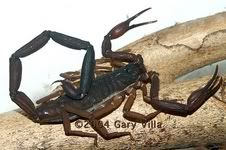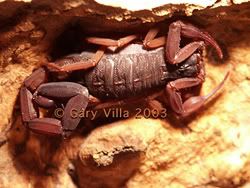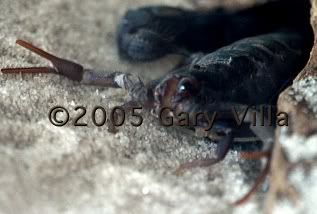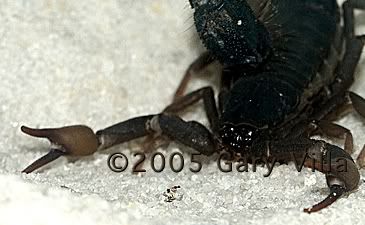- Joined
- Nov 7, 2003
- Messages
- 492
Note from Kugellager: This thread will be strictly moderated and anything not pertaining directly to Sexing a Scorpion will be deleted.
Thanks,John
Arachnoboards
];')
I was just thinking that it might be good to have a thread which addresses the different ways of sexing different groups of scorpions. Since sexing is a commonly raised question here, and since sexual dimorphism varies among different groups of scorpions, both in amount and type, it would be nice to have a single resource to refer people to so that they could easily see (in those species where it is easy to see) the differences. People who have pics of both male and female of genera or species, showing how to tell the difference, could post them, possibly along with a short description of what to look for, and a title listing the species or genus. It might even be nice to make it a sticky, or include it in one of the other stickies on scorp info.
I'll start, with one of the easier groups, Centruroides. Generally, species in this genus show a marked difference between males and females, at least at maturity, with males having a thinner, slighter build, and especially a difference in the last couple of metasomal (tail) segments. In mature males, the metasomal segments are noticeably longer and thinner than in females and juveniles of either sex. Below are pictures of male and female Centruroides gracilis for comparison:
 Male
Male
 Female
Female
While the difference isn't always quite so extreme, this is generally the pattern in Centruroides species, and is the easiest way to sex them.
Thanks,John
Arachnoboards
];')
I was just thinking that it might be good to have a thread which addresses the different ways of sexing different groups of scorpions. Since sexing is a commonly raised question here, and since sexual dimorphism varies among different groups of scorpions, both in amount and type, it would be nice to have a single resource to refer people to so that they could easily see (in those species where it is easy to see) the differences. People who have pics of both male and female of genera or species, showing how to tell the difference, could post them, possibly along with a short description of what to look for, and a title listing the species or genus. It might even be nice to make it a sticky, or include it in one of the other stickies on scorp info.
I'll start, with one of the easier groups, Centruroides. Generally, species in this genus show a marked difference between males and females, at least at maturity, with males having a thinner, slighter build, and especially a difference in the last couple of metasomal (tail) segments. In mature males, the metasomal segments are noticeably longer and thinner than in females and juveniles of either sex. Below are pictures of male and female Centruroides gracilis for comparison:


While the difference isn't always quite so extreme, this is generally the pattern in Centruroides species, and is the easiest way to sex them.
Last edited:














